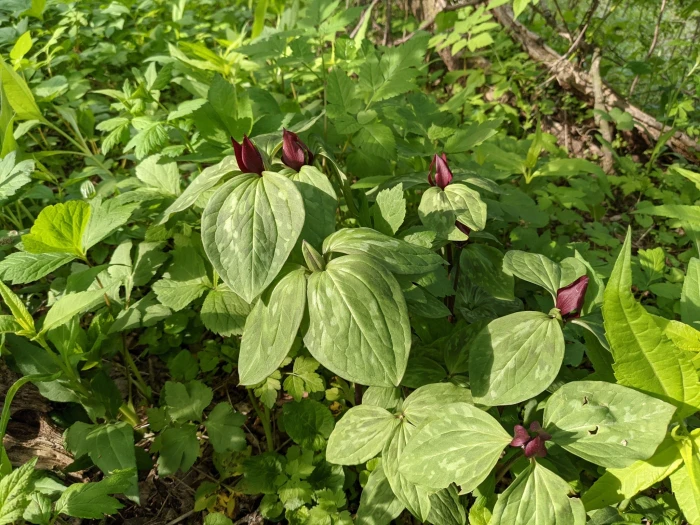Prairie Trillium
(Trillium recurvatum)
Prairie Trillium (Trillium recurvatum)
/
/

Ethan Rose
CC BY 4.0
Image By:
Ethan Rose
Recorded By:
Copyright:
CC BY 4.0
Copyright Notice:
Photo by: Ethan Rose | License Type: CC BY 4.0 | License URL: http://creativecommons.org/licenses/by/4.0/ | Rights Holder: Ethan Rose | Publisher: iNaturalist | Date Created: 2021-05-14T16:47:34-07:00 |




















































Estimated Native Range
Climate Requirements for Vernon Hills, Illinois
| This Plant | Your Site | Plant Suitability for Your Location | ||
|---|---|---|---|---|
| • Precipitation | 30" - 61" | 35" | Your precipitation may be insufficient for this plant. Irrigate N" / year. | Irrigate N" / year |
| • High Temp. | 64°F - 94°F | 83°F | Your summer temperatures are normal for this plant. | Excellent |
| • Low Temp. | 3°F - 36°F | 13°F | Your winter temperatures are normal for this plant | Excellent |
This plant should grow well at your location with about N inches per year (Y minutes per month) of irrigation.
Summary
Trillium recurvatum, commonly known as Prairie Trillium, is a deciduous perennial herb native to rich woodlands and floodplain forests in the Central and Eastern USA. It typically grows up to 40 cm (16 in) tall and is known for its distinctive three-petaled flowers. The flowers, which bloom in early spring, have brown to maroon petals that are 1.8 to 4.8 cm (1 to 2 in) long and 0.9 to 2 cm (0 to 1 in) across. The petals arch gracefully over the stamens, and the sepals are recurved, pointing downwards when the flower is fully open. The anthers are dark purple, up to 16 mm (1 in) long, and the stigmas are recurved at the tips. Prairie Trillium is distinguished from other sessile-flowered Trillium species, such as Trillium sessile, by its reflexed sepals. The fruit is green, sometimes streaked with purple or white, and has six well-developed ridges. Seeds have an oil-rich structure called an elaiosome, which attracts ants and other foraging insects, aiding in seed dispersal.
Prairie Trillium is valued for its unique flowers and is often used in woodland gardens, shade gardens, and native plant collections. It is relatively low-maintenance, requiring medium amounts of water and thriving in part shade to full shade. It prefers humus-rich, well-drained soil. While it is not typically prone to serious diseases or pests, it can be slow to establish and spread. Gardeners should be aware that all parts of the plant are toxic if ingested. Due to its attractiveness to pollinators and its role in natural ecosystems, it is a beneficial addition to biodiversity-friendly gardens.CC BY-SA 4.0
Prairie Trillium is valued for its unique flowers and is often used in woodland gardens, shade gardens, and native plant collections. It is relatively low-maintenance, requiring medium amounts of water and thriving in part shade to full shade. It prefers humus-rich, well-drained soil. While it is not typically prone to serious diseases or pests, it can be slow to establish and spread. Gardeners should be aware that all parts of the plant are toxic if ingested. Due to its attractiveness to pollinators and its role in natural ecosystems, it is a beneficial addition to biodiversity-friendly gardens.CC BY-SA 4.0
Plant Description
- Plant Type: Herb
- Height: 1-1.5 feet
- Width: 0.8-1 feet
- Growth Rate: Slow
- Flower Color: Brown, Purple, Red
- Flowering Season: Spring
- Leaf Retention: Deciduous
Growth Requirements
- Sun: Part Shade, Full Shade
- Water: Medium
- Drainage: Medium
Common Uses
Bee Garden, Butterfly Garden, Deer Resistant, Low Maintenance, Rock Garden
Natural Habitat
Rich woodlands and floodplain forests
Other Names
Common Names: Bloody Butcher, Toadshade
Scientific Names: Trillium recurvatum, Trillium recurvatum f. shayi, Trillium recurvatum f. luteum, Trillium recurvatum f. recurvatum, Phyllantherum recurvatum, Trillium recurvatum f. esepalum, Trillium recurvatum f. foliosum, Trillium recurvatum f. petaloideum, Trillium unguiculatum
GBIF Accepted Name: Trillium recurvatum L.C.Beck